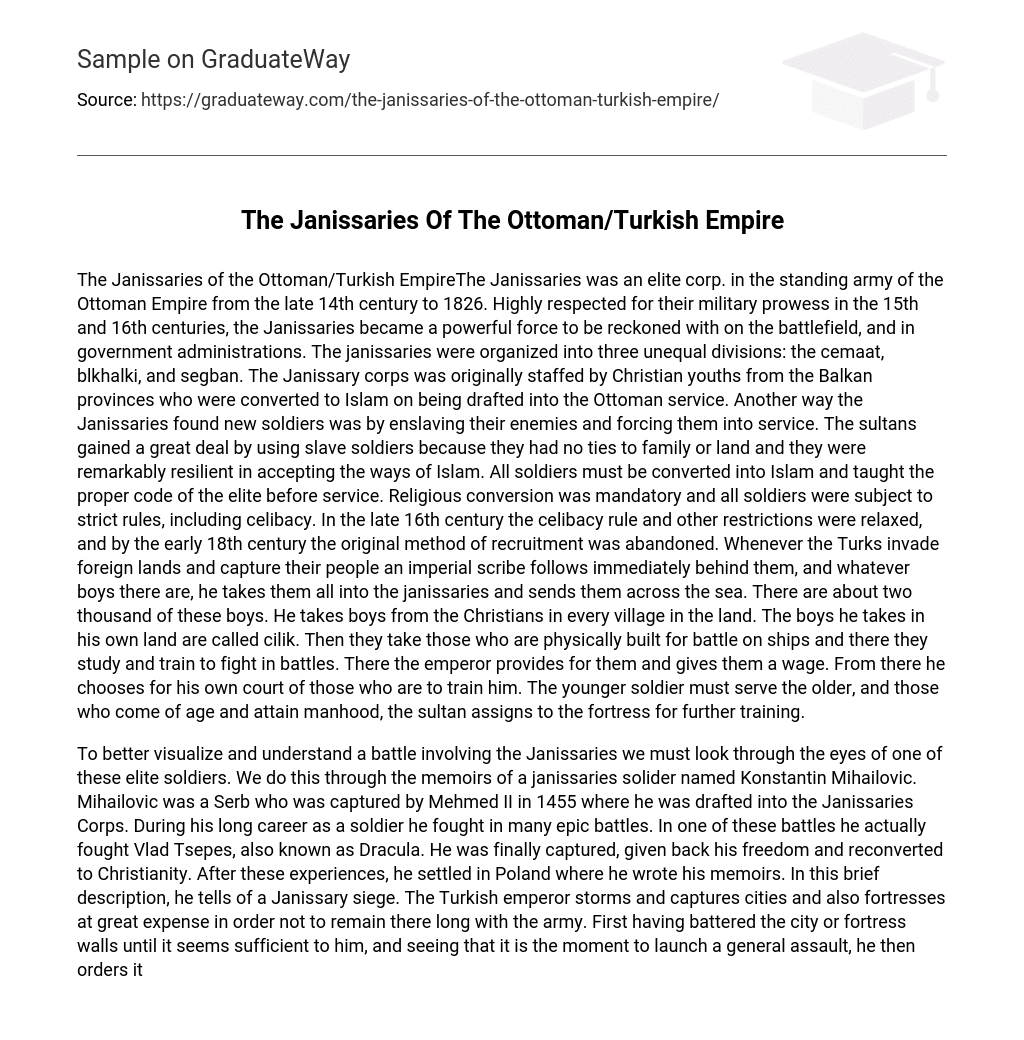The Janissaries of the Ottoman/Turkish EmpireThe Janissaries was an elite corp. in the standing army of the Ottoman Empire from the late 14th century to 1826. Highly respected for their military prowess in the 15th and 16th centuries, the Janissaries became a powerful force to be reckoned with on the battlefield, and in government administrations. The janissaries were organized into three unequal divisions: the cemaat, blkhalki, and segban. The Janissary corps was originally staffed by Christian youths from the Balkan provinces who were converted to Islam on being drafted into the Ottoman service. Another way the Janissaries found new soldiers was by enslaving their enemies and forcing them into service. The sultans gained a great deal by using slave soldiers because they had no ties to family or land and they were remarkably resilient in accepting the ways of Islam. All soldiers must be converted into Islam and taught the proper code of the elite before service. Religious conversion was mandatory and all soldiers were subject to strict rules, including celibacy. In the late 16th century the celibacy rule and other restrictions were relaxed, and by the early 18th century the original method of recruitment was abandoned. Whenever the Turks invade foreign lands and capture their people an imperial scribe follows immediately behind them, and whatever boys there are, he takes them all into the janissaries and sends them across the sea. There are about two thousand of these boys. He takes boys from the Christians in every village in the land. The boys he takes in his own land are called cilik. Then they take those who are physically built for battle on ships and there they study and train to fight in battles. There the emperor provides for them and gives them a wage. From there he chooses for his own court of those who are to train him. The younger soldier must serve the older, and those who come of age and attain manhood, the sultan assigns to the fortress for further training.
To better visualize and understand a battle involving the Janissaries we must look through the eyes of one of these elite soldiers. We do this through the memoirs of a janissaries solider named Konstantin Mihailovic. Mihailovic was a Serb who was captured by Mehmed II in 1455 where he was drafted into the Janissaries Corps. During his long career as a soldier he fought in many epic battles. In one of these battles he actually fought Vlad Tsepes, also known as Dracula. He was finally captured, given back his freedom and reconverted to Christianity. After these experiences, he settled in Poland where he wrote his memoirs. In this brief description, he tells of a Janissary siege. The Turkish emperor storms and captures cities and also fortresses at great expense in order not to remain there long with the army. First having battered the city or fortress walls until it seems sufficient to him, and seeing that it is the moment to launch a general assault, he then orders it to be cried throughout the army. A second cry is sent telling the army what day the actual siege will proceed. Most emperors preferred to attack on Friday. Carrying this cry, and also waving the army banner, was a special responsibility. The soldier who did this often received a volvodeship, or governorship. They also received money and various expensive garments. And at night then they go toward the city from all sides silently, slowly approaching the fosse ditch, carrying before them barricades woven of branches and also strongly-built ladders so that they can climb up and down the fortress wall. They then after approaching the breached wall, wait until daylight. Next the gunners fire all their cannons and the Janissaries quickly scale the walls forcing the Christians back. At the same time thick showers of arrows dissipate the retreating enemies. The battles usually lasted an hour or two hours at the most. If the assault last until noon, it was usually lost because the ammunition is used up. If the fortress or city can defend itself, the emperor will not make another attempt for a long time.
Toward the end of the eighteenth century, internal disorder which threatened the dismemberment of the empire, and military weakness, which had resulted in loss of territories in Europe, made current Ottoman leader realize that changes were essential if the state were to survive. Sultan Mustafa III (1757-74) was convinced that western ways would have to be adopted. Selim III, Sultan from 1789 to 1807, planned army reforms and opened military schools to train Turkish officers in European methods. Although he was murdered by radical Janissaries, an increasing number of Turkish officers awakened to the necessity of drastic reforms. The Janissaries were the main opposition to change. They had become dependant on the old society and they used this power to attempt to control the upper levels of the Turkish government and corruption began to take root. The reigning sultan, Sultan Mahmoud came to the conclusion that the Janissaries would cause the downfall of his empire. He decided that drastic measures must be taken. In the infamous Auspicious Incident Mahmound created a new, westernized army to combat the Janissaries. Outraged at this, the Janissaries revolted against the sultan and massacred by the larger more modern army. Those who were not killed were captured and executed. The power of the Janissaries was broken; those corps who was not killed was disbanded, and this ancient military order was outlawed throughout the empire. The door to military and civil reform was now open to reformist ministers. However, the door to the greatest army corp. in the entire Turkish history was closed.





